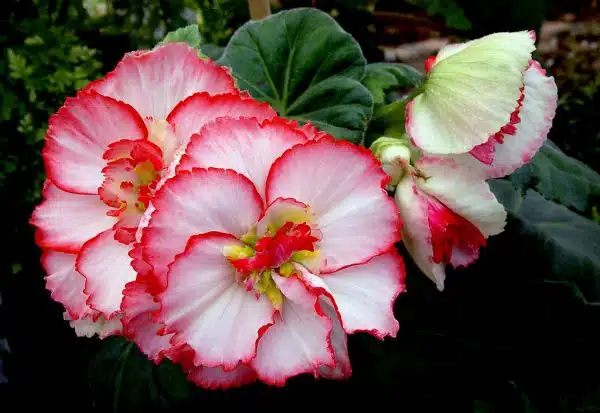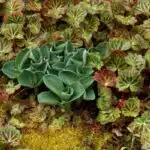Begonias are one of the most popular and highly sought-after plants in horticulture due to their bright and colorful flowers, unique foliage, and easy maintenance. These native plants from South and Central America come in a wide range of colors, shapes, sizes and bloom patterns, making them an excellent addition to any garden or landscape design. Whether planted in containers or garden beds, begonias can transform any space with their vibrant hues and lush foliage.
As a plant specialist, it is important to understand the different types of begonias available and how to properly care for them. By mastering the basics of growing begonias, horticulturists can help others discover the beauty of these remarkable plants while providing valuable insights into cultivation techniques such as lighting requirements, soil preparation, watering schedules, fertilization methods and pest control measures. This article aims to provide an in-depth introduction to growing begonias that will serve as a useful resource for both novice and experienced growers looking to enhance their gardening skills.
Understanding The Different Types Of Begonias
Begonias are a popular choice for gardeners and houseplant enthusiasts due to their colorful blooms, unique foliage, and wide range of varieties. There are over 1,000 known species of begonias, with new ones being discovered each year. As a result, it can be overwhelming to choose the right type of begonia for your needs.
To make things easier, it is important to understand the different types of begonias available. Begonia varieties can be divided into four main groups: fibrous-rooted begonias, rhizomatous begonias, tuberous begonias, and cane-like or angel-wing begonias. Fibrous-rooted begonias are the most common type and are often used as bedding plants or in container gardens. Rhizomatous begonias have thick stems that grow horizontally along the soil surface and are known for their interesting leaf patterns. Tuberous begonias produce large flowers in a variety of colors and require a dormant period during winter months. Cane-like or angel-wing begonias are tall plants with elongated leaves that resemble wings.
Identifying begonia species requires careful attention to detail as there are many variations within each group. Characteristics such as leaf shape and size, flower color and shape, stem structure, and growth habit all play a role in identifying the specific type of begonia you have. By understanding the differences between each group and paying attention to these details, you can select the perfect type of begonia for your indoor or outdoor space. In the next section, we will discuss how to provide adequate lighting for your chosen variety of begonia.
Choosing The Right Lighting For Your Begonias
Like the sun is to a flower, proper lighting is vital to the growth and development of begonias. Choosing the right lighting for your begonias can make all the difference in their overall health and appearance. Begonia lighting options range from natural light to artificial grow lights, each with its own set of advantages and disadvantages.
Factors affecting begonia lighting include the intensity, duration, and quality of light. Intensity refers to how bright or dim the light source is. Duration refers to how long the plant is exposed to light daily. Quality refers to the type of light spectrum emitted by the source, which affects photosynthesis and plant growth. Understanding these factors will help you choose the right lighting for your begonias based on their specific needs.
When it comes to choosing lighting for your begonias, consider their natural habitat and mimic those conditions as closely as possible. Typically, begonias thrive in bright but indirect sunlight or partial shade. However, depending on the variety of begonia you have, they may require more or less intense lighting conditions. Experimenting with different light sources and observing how your plants react can help you find the optimal conditions for your begonias’ growth and development. In our next section, we will explore how preparing the perfect soil mix can further enhance your begonia’s optimal growth potential.
Preparing The Perfect Soil Mix For Optimal Growth
To ensure optimal growth and health of your begonias, it is essential to prepare the perfect soil mix. The ideal soil mix should be well-draining and rich in nutrients, with a pH level ranging from 5.5 to 6.5. You can achieve this by adding various soil amendments and using composting techniques.
The first step in preparing your soil mix is to choose the right base material. A good base material should be light, porous, and hold moisture well. Peat moss, vermiculite or perlite are great options to consider as they improve soil aeration and retain moisture without becoming waterlogged. To enhance the nutrient content of your soil mix, you can add organic matter such as compost, leaf mold or aged manure.
Incorporating composting techniques into your soil preparation process will also help create an enriched environment for your begonias’ roots to thrive. You can make your own compost by combining kitchen scraps, yard waste, and other organic materials in a compost bin or pile. Once the compost is ready, it can be added to your soil mix in small amounts to increase its fertility and improve its water-holding capacity.
As you prepare your begonias’ ideal growing environment through proper soil preparation techniques, remember that watering practices are equally crucial for their growth and survival. In the next section, we will explore some dos and don’ts of watering begonias that will help keep them healthy and thriving throughout their life cycle.
Watering Your Begonias: Dos And Don’ts
As begonias are native to tropical regions, they thrive in humid environments. When it comes to watering your begonias, the key is to maintain a consistent level of moisture without overwatering. Begonias prefer slightly moist soil, but they do not tolerate standing water or soggy conditions. Therefore, it is important to keep an eye on your watering frequency and soil moisture levels.
To ensure optimal growth and health for your begonias, follow these dos and don’ts when watering:
- Do water your begonias when the top inch of soil feels dry to the touch.
- Do use room temperature water to avoid shocking the roots.
- Don’t let your begonias sit in standing water, as this can lead to root rot.
- Don’t overwater your begonias, as this can cause the roots to suffocate and lead to plant death.
By using these guidelines and monitoring your plant’s needs, you can help prevent common problems such as yellowing leaves or stunted growth. It’s important to note that different varieties of begonias have varying water requirements, so be sure to research the specific needs of your particular plant.
Next up: fertilizing your begonias. Tips and tricks for promoting healthy growth and vibrant flowers will be discussed in detail in the following section.
Fertilizing Your Begonias: Tips And Tricks
After learning about the dos and don’ts of watering your begonias, it’s time to move on to fertilizing. Fertilizers are essential in providing nutrients that your begonias need for optimal growth and development. A well-fed begonia will produce more flowers and a fuller foliage, making it an attractive addition to your garden.
Organic options are becoming increasingly popular among growers due to their environmental benefits. Organic fertilizers such as compost, bone meal, and fish emulsion are excellent choices for those who prefer natural alternatives. These organic options provide a slow-release of nutrients that last throughout the season.
When applying fertilizers, it’s important to consider seasonal application. During the active growing season of spring and summer, weekly applications may be necessary to keep up with the plant’s demands. However, during winter or dormancy periods, it’s best to reduce or stop fertilization altogether.
Fertilizing your begonias is an essential step in maintaining healthy plants. By choosing organic options and considering seasonal application, you can ensure that your begonias receive the necessary nutrients for optimum growth and development. In our next section, we will discuss pest control measures for healthy plants.
Pest Control Measures For Healthy Plants
Imagine tending your garden with love and care, only to see your begonias plagued by pests. It can be a devastating sight for any plant enthusiast. As a horticulturalist, I understand the importance of pest control measures in maintaining healthy plants. In this section, we will explore natural remedies and chemical options for controlling common begonia pests.
Natural remedies are an environmentally friendly way of controlling pests without harming the ecosystem. For instance, ladybugs are natural predators that feed on aphids and mites. By releasing them into your garden, you can help reduce the population of these pests. Additionally, neem oil is an effective natural pesticide that controls fungal diseases such as powdery mildew and black spot.
Chemical options are usually considered as a last resort when natural remedies fail to control pest infestations. However, it is essential to use chemicals responsibly and follow all safety precautions to avoid harming yourself or the environment. Some effective chemical pesticides for begonias include Malathion and Permethrin. However, always read labels carefully before applying any chemical option.
Now that we have explored various pest control measures let’s move onto propagation techniques: how to multiply your begonias.
Propagation Techniques: How To Multiply Your Begonias
Begonias are a popular houseplant that can be propagated through various techniques. One of the most common methods is through leaf cuttings, where a healthy leaf is taken from the plant and rooted in soil or water. This method works best with mature leaves that have prominent veins, as they have a higher chance of rooting successfully. To begin, select a healthy leaf and make a clean cut at the base of the stem. Remove any excess leaves near the bottom of the cutting and place it in water or moist soil until roots begin to form.
Division methods are another way to propagate begonias. This technique involves separating the plant into smaller sections, each with its own root system. This method is useful for larger plants that have multiple stems or rhizomes. To divide your begonia, gently remove it from its pot and separate it into smaller sections using a sharp knife or garden shears. Be sure to leave enough roots on each section and replant them in fresh soil.
When propagating your begonias, it’s important to remember that not all methods will work for every variety of begonia. Some species may require specific conditions or care during propagation, so always do your research before attempting any techniques. By mastering these propagation techniques, you can easily multiply your collection of beautiful begonias and share them with others.
Moving forward, now that you know how to propagate your begonias successfully, it’s important to know when and how to repot them properly. In the next section, we will explore everything you need to know about repotting your begonias: when to do it, how often, and what type of soil and pot size works best for their growth needs.
Repotting Your Begonias: When And How To Do It
Repotting your begonias is a crucial step in their growth and care. As horticulturalists, we understand that the idea of repotting can seem daunting to some plant enthusiasts. However, with the right tools and knowledge, this process becomes easier than expected.
Firstly, it’s important to have the best tools for repotting your begonias. A sharp pair of scissors or pruning shears will come in handy when trimming any damaged roots or stems. Additionally, a trowel or scoop will help you transfer soil from the old pot to the new one without causing too much disturbance to the plant’s root system. As for frequency, it is recommended that you repot your begonias every 1-2 years depending on their growth rate.
Secondly, understanding the ideal pot size for your begonia is key. If your plant has outgrown its current pot or if you notice that its roots are beginning to grow through the drainage holes at the bottom of the pot, then it may be time to consider repotting. Another sign that your begonia needs repotting is if you notice a lack of growth or yellowing leaves despite proper care. In such cases, it is important to act quickly and provide your plant with fresh soil and adequate space.
In conclusion, repotting your begonias may seem like a daunting task at first but with practice and patience, it becomes an easy part of their overall care routine. By using the best tools available and understanding when and how frequently to repot them based on visual clues such as root growth and changes in foliage coloration, you can ensure healthy growth for your beloved plants. In our next section, we will explore common issues that arise during begonia care and how to solve them seamlessly without causing any harm to these beautiful plants.
Common Issues And How To Solve Them
Pest control is an important factor in successful begonia cultivation. Care should be taken to regularly inspect the plants to identify and eliminate any pests that may be present. Overwatering is a common issue with begonias; it is recommended that the soil is allowed to dry between waterings. Fertilizing is important for begonias to maintain their lush foliage. It is recommended that a balanced fertilizer be applied every two to four weeks. Sunlight requirements for begonias vary depending on the variety; it is important to research the needs of the specific begonia being grown.
Pest Control
As a horticulturalist, I understand the importance of taking measures to control pests in order to maintain the health and beauty of your begonias. Common pests that may infest your plants include spider mites, aphids, and mealybugs. These pests can cause damage by feeding on the plant’s leaves, stems, and flowers, which can lead to stunted growth and even death.
Fortunately, there are both natural remedies and chemical options available for controlling these pests. Natural remedies such as neem oil or insecticidal soap are effective at controlling most common garden pests. These options work by suffocating or dehydrating the pests without damaging the plant itself. Chemical options such as pyrethrin-based sprays can also be used but should be used with caution as they can harm beneficial insects.
It is important to regularly inspect your begonias for signs of pest infestations and take action immediately if needed. By utilizing natural remedies or chemical options when necessary, you can effectively control pesky insects while ensuring that your begonias remain healthy and beautiful.
Overwatering
Maintaining the health and beauty of your begonias requires a keen eye for potential issues. One common issue that can affect these plants is overwatering. As a horticulturalist, I understand the importance of taking preventive measures to avoid this problem. Overwatering can lead to root rot, which can ultimately kill your begonias.
To prevent overwatering, it’s crucial to be mindful of how much water your begonias receive. Signs of overwatering include yellowing leaves, wilting foliage, and a general lack of growth. It’s important to use well-draining soil and to allow the soil to dry out between watering sessions. Additionally, it’s recommended to water in the morning rather than the evening to allow excess moisture to evaporate before nighttime. By implementing these preventive measures, you can avoid overwatering and keep your begonias healthy.
If you do notice signs of overwatering in your begonias, it’s important to take action immediately. Remove any affected leaves or stems and adjust your watering schedule accordingly. Be sure not to water until the soil has dried out completely. With proper care and attention, you can ensure that your begonias thrive without succumbing to common issues such as overwatering or pest infestations.
Showcasing Your Begonias: Creative Design Ideas For Your Garden Or Home
Begonias are a fantastic addition to any garden or home, and there are many creative ways to showcase their beauty. One option is to create vertical displays, which can be achieved by hanging baskets or planting them in a wall-mounted planter. This not only adds visual interest but also maximizes space in smaller gardens or homes. When designing a vertical display, consider using different varieties of begonias with varying colors and textures to create an eye-catching arrangement.
Another unique way to showcase begonias is through the use of terrariums. A Begonia terrarium is essentially a miniature garden enclosed in glass, allowing for easy viewing of the plants while also providing protection from harsh elements. These can be created with various sizes and shapes of containers, making them versatile for any space. When creating a Begonia terrarium, it is important to select the right soil mixture and drainage system to ensure proper growth and health for the plants.
Incorporating creative design ideas such as vertical displays and Begonia terrariums into your garden or home allows for an aesthetically pleasing environment while also showcasing the beauty of these magnificent plants. With careful consideration of color schemes, texture variations, and appropriate growing conditions, you can create stunning displays that will leave guests in awe. Don’t be afraid to experiment with different arrangements and combinations to find what works best for your space – the possibilities are endless!
Conclusion
Begonias can be a stunning addition to any garden or home, but their optimal growth requires careful attention to several factors. Understanding the different types of begonias and choosing the right lighting and soil mix are crucial for healthy growth. Over-watering or under-fertilizing can also hinder their development. Propagation techniques and repotting should be done carefully to ensure success.
Despite your best efforts, common issues like pests and diseases may arise. However, with proper knowledge and problem-solving skills, these issues can be resolved effectively. Begonias offer endless possibilities for creative design ideas in your garden or home.
As a horticulturalist or plant specialist, it is my hope that this introduction has inspired you to explore the world of growing begonias further. With patience and diligence, these beautiful plants can thrive in almost any setting. Whether you choose to showcase them in a hanging basket or as a centerpiece on your dining table, the rewards of successful begonia growth are sure to bring joy and beauty into your life.
Image Credits
- “Begonias” by Bernard Spragg (featured)





























